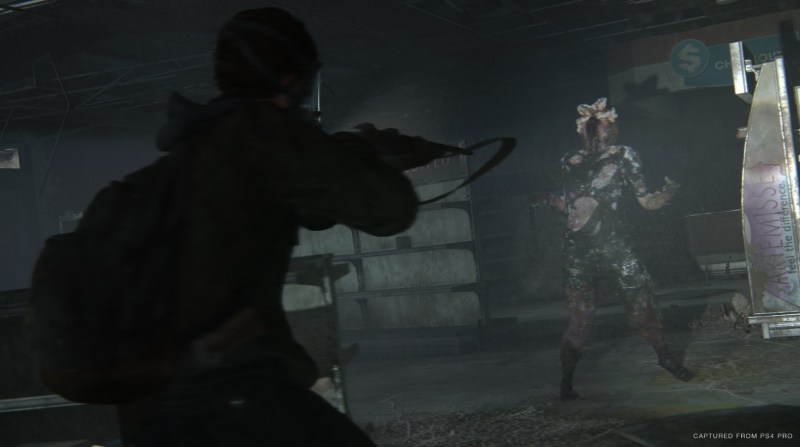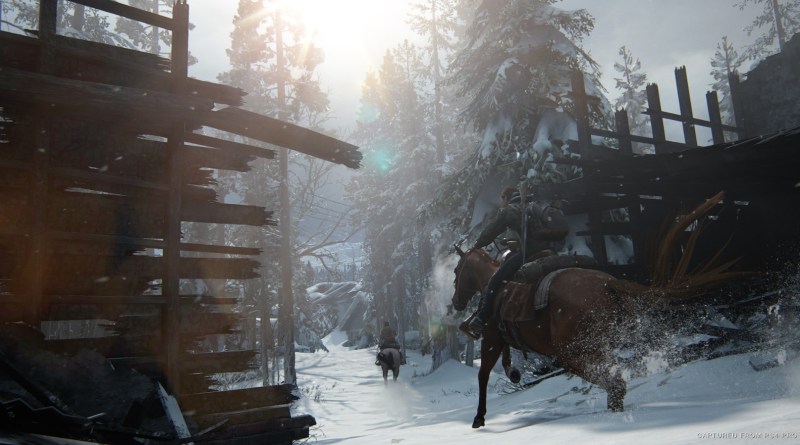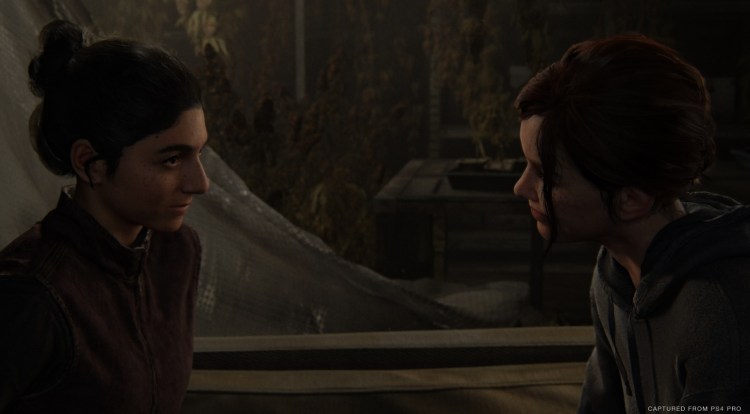
Above: Those Clickers are back in The Last of Us Part II.
In terms of the melee combat, we’ve added a whole new dimension to the gameplay. We’ve never been able to support one-on-one melee duels before, like you had with the guy you took the bow from, Boris. By adding a dodge button, we’re able to take that gameplay a new level, but also do it in this way that, visually, is unique to us. There’s a great deal of fidelity. That’s the thing I’m most excited about.
Another example, we have this new upgrade system where it allows you to express yourself creatively in the strategy that you want to pursue. We’ve had an upgrade system before, and it had some great aspects, but in some ways it was just stat boosts. You were just raising certain stats about yourself. We still have upgrades like that, but we also have stuff where you get entirely new abilities that are unlocked through the upgrade system, that you can choose to have or not have. For example, crafting the silencer item, that’s something you have to choose to pursue. You can do that at the expense of some other upgrade that might be important to you.
Some of these are quite game-changing. You can shorten the length of the stealth kill dramatically — something like a third of the length — which can make you much more efficient. You can increase your prone movement speed, so as you move through grass — sometimes I feel like a land shark, cruising around and taking people down. You can even get an upgrade where you create two smoke bombs for the price of one. You can alter the game’s economy in a way where you’re now leaning way heavier on a mechanic because you can craft more items per resource. That’s one way the gameplay is way more flexible.
I’ve had to play this demo about a million times, and it never gets boring, because there are so many new ways to approach each encounter, so many new upgrades to experiment with. There are lots of synergies to discover and experiment with.
GamesBeat: How did you get so much more visual improvement out of the same platform? You’re still on the PS4.
Newman: Honestly, I don’t have the technical expertise to really know about that. But it does look phenomenal. The vast majority of it isn’t just stuff that you get from raw power, just putting more polygons on screen. Most of the things that are really striking to look at are from new techniques, new things that aren’t necessarily — they’re more expensive, but it’s really the cleverness of the algorithm that makes them so cool.
A big one that I’m excited about is called motion matching. It’s this algorithm where — normally, in player navigation systems, the system that governs Ellie and the enemy NPCs moving around the space — normally you program it in such a way where, if you press forward, play the run forward animation. Press left, play this turn animation and then play the left run animation.
Motion matching, instead, has this huge bucket of animations. They mocapped someone running around a space, doing all these loops and turns, and chopped that animation into really small pieces. Based on your stick input and the speed you were going and the speed your about to move to, it pulls three or four animations from that pool and blends them together in just the right way to get the perfect motion from where you were going to get to.
I remember when they turned that on. I couldn’t believe it. It was this incredible next-gen leap. Again, it’s purely a technique. We didn’t need that much more hardware in order to run that. It was just the cleverness of the technique.
GamesBeat: I thought you were actually going to wait for the PS5 to come along.
Newman: Apparently not!

Above: On patrol in The Last of Us Part II.
GamesBeat: One thing I liked about the original game was that you care for this other person, but you’re also constantly worried that one of you is going to get into some serious trouble. It seems like that’s something you’re grabbing onto again. It’s a source of engagement, or tension, another way to make this a gripping story.
Newman: What we say a lot, or what we talk about a lot, is that our world is one with high stakes. Death can come swiftly and at any time for any of these characters. We do a lot of work making you care about them, showing that they’re vulnerable humans, building your empathy for them. The scene where Ellie and Dina are in the grow house — that, to me, reminds me a lot of situations I’ve been in, in high school or something, that kind of early romance. Those tentative first steps to falling in love with someone.
That’s a big part of why the way the violence is portrayed in the game is so gritty and so realistic. It makes it clear that the stakes are always very high. One way we achieve that is by making the enemy AI feel very human. That’s why we pursued creating names for all of our NPCs, so they could call each other by name and react in anguish when they see a friend die. That makes them feel like they’re intelligent and deadly, because they react in a way that human beings would react. That just raises the stakes. You’re dealing with humans who will do anything to survive. Those are the stakes in this world.
GamesBeat: And since this is a story about revenge, we know something bad has happened.
Newman: The event, yes. [chuckles]
GamesBeat: Is there anything else you’d like to cover?
Newman: The thing I really want people to understand about this game is that — as high as the expectations are for the sequel to such a highly-regarded game, I think that we’re going to go beyond those expectations. From the sound design to the AI to the environments to the level design, the breadth of the level design — we’re doing wide and vertical environments. You can see from the trailer that the breadth of places you go to, from the flooded city to these forests to all these different places — it really is far and away the most ambitious game we’ve ever made. I can’t wait for people to play it.

